
Project Gutenberg's Making a Poultry House, by Mary Roberts Conover This eBook is for the use of anyone anywhere at no cost and with almost no restrictions whatsoever. You may copy it, give it away or re-use it under the terms of the Project Gutenberg License included with this eBook or online at www.gutenberg.org Title: Making a Poultry House Author: Mary Roberts Conover Release Date: December 20, 2013 [EBook #44472] Language: English Character set encoding: ISO-8859-1 *** START OF THIS PROJECT GUTENBERG EBOOK MAKING A POULTRY HOUSE *** Produced by Sandra Eder and the Online Distributed Proofreading Team at http://www.pgdp.net (This file was produced from images generously made available by The Internet Archive)

MAKING A
POULTRY HOUSE
THE
HOUSE & GARDEN
MAKING
BOOKS
It is the intention of the publishers to make this series of little volumes, of which Making a Poultry House is one, a complete library of authoritative and well illustrated handbooks dealing with the activities of the home-maker and amateur gardener. Text, pictures and diagrams will, in each respective book, aim to make perfectly clear the possibility of having, and the means of having, some of the more important features of a modern country or suburban home. Among the titles already issued or planned for early publication are the following: Making a Rose Garden; Making a Lawn; Making a Tennis Court; Making a Fireplace; Making Paths and Driveways; Making a Rock Garden; Making a Garden with Hotbed and Coldframe; Making Built-in Bookcases, Shelves and Seats; Making a Garden to Bloom This Year; Making a Water Garden; Making a Garden of Perennials; Making the Grounds Attractive with Shrubbery; Making a Naturalized Bulb Garden; with others to be announced later.
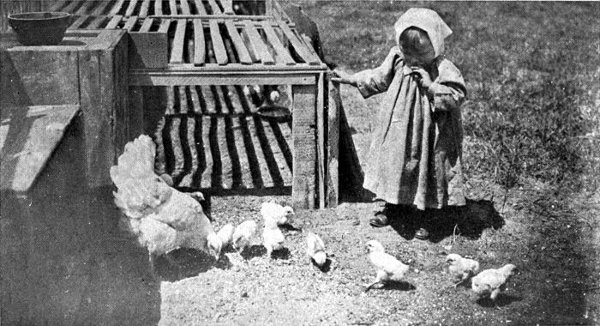
It is not a difficult matter to care for a small flock, but the old unsanitary methods of housing will have to be abandoned
By M. ROBERTS CONOVER

NEW YORK
McBRIDE, NAST & COMPANY
1912
Copyright, 1912, by
McBRIDE, NAST & CO.
Published May, 1912
| PAGE | |
| Introduction | 1 |
| Specific Suggestions for Houses | 7 |
| Floors and Foundations | 23 |
| The Roof | 28 |
| Walls, Windows and Ventilation | 33 |
| The Door of the Poultry House | 40 |
| Nests and Roosts | 43 |
| The Run | 50 |
| Some Hints on Upkeep | 52 |
| Unsanitary Housing Must Give Way to Modern Methods | Frontispiece |
| FACING PAGE |
|
| A Colony House Recommended by the Oregon Experiment Station | 12 |
| Two Portable Colony Houses Adaptable for the Home Flock | 16 |
| Brood Houses for the Young Birds | 20 |
| Floors of Earth and of Wood | 26 |
| The Single-pitch Roof in a Series of Connected Houses | 30 |
| A Combined Poultry House and Pigeon Loft | 38 |
| Alfalfa Under Netting in the Run | 46 |
| A Simple Form of Trap Nest | 46 |
Making a Poultry House
To close one's eyes and dream of a home in the country with its lawns, its gardens, its flowers, its songs of birds and drone of bees, proves the sentimental in man, but he is not practical who cannot call into fancy's realm the cackle of the hen.
Having conceded her a legitimate place in the scheme of the country home, good housing is of the utmost importance, and it is in regard to this that one easily blunders. Few would idealize a rickety hovel as a home for the flock, but many of us, while we would not put our highly prized birds into an airtight box, so over-house2 them that they weaken instead of profiting by our care.
That the poultry house is yet in an evolutionary stage, all must admit, but no one can deny that great strides have been made since the once neglected barnyard fowl has come to be known as a very understandable and responsive creature, to be dealt with on common-sense grounds.
Only that poultry house is a good shelter which in winter conserves as much warmth as possible, and yet permits an abundance of fresh air; that admits sunlight, and yet in summer is cool. Such a building must offer no hospitality to other than poultry life, and it must be constructed in line with the economic value of its residents. In short, the structure must be so contrived as to guard against drafts, dampness, disease, and vermin, to insure a profitable result. A maximum of3 comfort with a minimum of risk insures healthy poultry.
The location of the poultry house has an important bearing upon the style of the building. It is better to put the building where the land will slope away from, rather than toward, it. A large and durable poultry house was recently built and afterwards condemned by its owners as damp. The land sloped slightly towards the building, but sufficiently to convey all surface water towards it, making its earth floor always damp in wet weather. If no other site can be secured, then it is better to mount the building on posts rather than on the ordinary foundation. If one has room enough to consider the kind of soil, sand is best, as it dries quickly, and the runs—one can scarcely consider the building without runs—can be kept much cleaner.
4A windbreak of some kind on the cold side of the building is a decided advantage—a wall, an evergreen hedge, a grove, or other buildings, will protect the poultry house, and, perhaps, also a portion of the runs, with benefit to the poultry.
In that the family flock may range in size from half a dozen to fifty or seventy-five fowls, the size of the building, and even its style, must vary to suit one's needs. A small coop, almost square, may house your flock of eight or ten, but the larger flock requires a house longer and higher, with more ample ventilation.
Ventilation by means of the canvas or burlap curtain has so simplified the fresh-air problem that less building room is needed where sleeping-quarters alone are considered. Hence the necessary house room for hens depends upon the mode of ventilation.
5That a large building with no direct ventilation is not so healthful for fowls as a small house that admits the fresh air direct, was proved in the case of a flock of fowls, during the last two winters. The previous winter seventy-five fowls were kept in a large building adjoining a barn. Its walls were thick, the place was very high and roomy. Ventilation was given through a loft. The quarters were kept clean, and all known rules of health observed. A glass door was fitted into the doorway, thus admitting sunlight to a small part of the floor. Not a hen was allowed to place her fair foot upon the cold snowy ground. The birds were taken sick with catarrhal troubles early in the winter, and were in an unpromising condition until spring. This last winter the birds, now forty in number, were housed in a seven by twelve building, seven feet high,6 with two windows in the front, each thirty-four inches wide and twenty-one inches high, placed one foot below the eaves, and one foot from the sides. Fresh air came through a canvas curtain in one window; the other had a glass sash. The birds came through the winter in fine condition. This building would have held the original number, but in that case the burlap curtain would have been used in the other window also.
The cooping of the young chicks must be considered as a problem somewhat distinct until they are old enough to contend with the other fowls for their rights.
Water-tight roofs, walls, and floors are essential to the life and health of the birds.
While no one style of hen house can meet all the conditions for all localities, almost any good model may be adapted to almost any locality, or at least suggest adaptable features.
The descriptions of houses that have been adapted as here given may easily suggest other modifications.
A house eight by seventeen feet should give ample roosting and nesting room for a flock of thirty or forty hens. One used by the author is seven feet wide, fifteen feet long, and ten feet high from peak to floor, and is satisfactory during spring, summer, and fall. In winter, however, a scratching-shed of equal area is desirable.8 It need not be higher than three feet. It should adjoin the hennery, and a section of its roof should be movable to allow a change of litter. The sunlight should be freely admitted to this through glass.
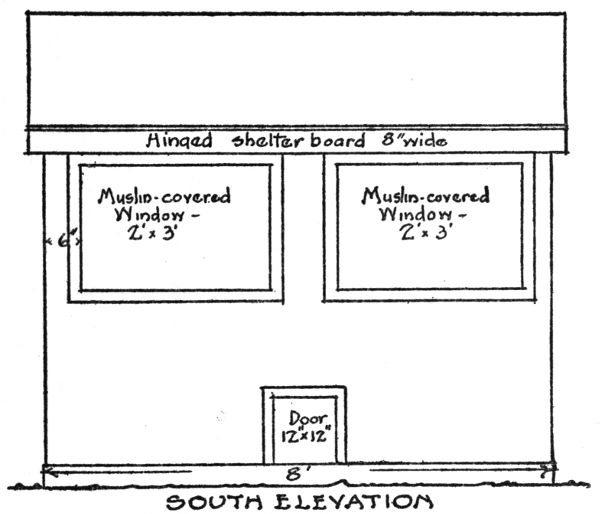
The front of a house that will shelter satisfactorily a dozen fowls
A small coop that will house a dozen fowls, and may be used where one has little space, or is just getting into poultry keeping, is eight feet long and six feet9 deep. It has a double-pitched roof, is five and one-half feet high from the lower edges of the roof to the foundation, and seven from the peak to the foundation. The eaves project four inches, but in front a board eight inches wide is hinged to the lower edge of the eaves. This is swung back and hooked against the side of the building on sunny days, but in rainy weather it is swung outward, thus extending the roof eight inches to prevent the rain from beating into the muslin-covered windows below. It is held in this position by brackets at either end, which are hinged to the building, and may be turned back against it when not in use.
Two windows, two feet high and three feet wide, are placed in the front, six inches from either side, thirty-four inches from the ground, and eight inches below the eaves. Burlap-covered frames are fitted10 to the windows, and these swing inward when necessary, and may be fastened by hooks suspended from the roof of the building.

The door may be at either end of the building and it must be made draft-proof
The building has a brick foundation and a concrete floor six inches higher than the surrounding surface of the ground, and on a level with the top of the foundation. At the rear are nests beneath the11 roosts. These are 14 in. long, 12 in. high, and 11 in. wide. There are seven on the bottom row placed alternately in a lengthwise and crosswise manner, and six above. The lower nests are improvised from boxes bought from a grocer's at five cents each, and are set upon a skeleton shelf raised 4 in. above the floor. The upper nests are likewise set upon a skeleton shelf 3 in. above the first tier. The sides of boxes are cut away to 5 in. height to allow the hens room to enter the nests. These nests are accessible to the hens from the front and are reached for egg collection by lifting a hinged door at the back; this door is 7 ft. long, 18 in. wide, and is 12 in. above the foundation in the rear.
The roosts are thirty-four inches above the floor, and run lengthwise of the house. Two will accommodate the small flock of twelve or fifteen fowls. Three inches below12 is the drop-board supported upon horizontal braces. It is in two sections, and slides out when desired. It is twenty inches wide, its outer edge being even with the first roost.
The walls are covered with sheathing paper laid inside over the studs, and tongue-and-groove boards are nailed over this. The outside is weather-boarded, and the roof covered with tarred paper over boards laid closely together. A door at one end, 26 in. wide and 5 ft. 6 in. high, gives access to the building, and a small door, 12 × 12 in., sliding in grooves, is placed in the front near the floor, for the use of the fowls.
This coop may be modified to suit individual preference; for instance, by giving it a single-pitched roof.
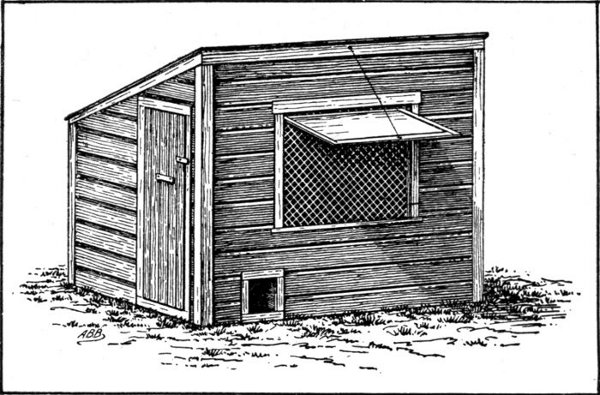
A portable colony house of simple design recommended by J. Dryden and A. G. Lunn in a bulletin of the Oregon Experiment Station
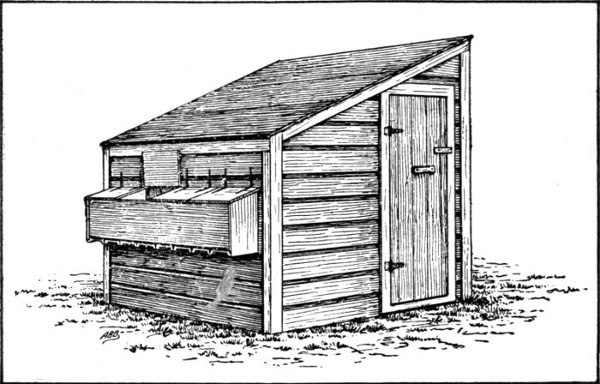
The rear of the same house, showing the extension nest boxes with individual covers
For the framework and inclosure these materials will be required:
| Hemlock or spruce for sills (5 × 6 in.)13 | 38 lineal feet |
| Hemlock or spruce for corner supports and plate to support rafters (3 × 4 in.) | 60 lineal feet |
| For intermediate supports, or studs, corner braces, and rafters (2 × 4) | 120 lineal feet |
For the roof beneath the tarred paper, 128 lineal feet of six-inch boards will be required, or 160 feet of five-inch boards; 400 lineal feet of five-inch weather boards will be required to inclose the building.
For the window and door casings 50 lineal feet of suitable lumber will be required, and 30 lineal feet of five-inch tongue-and-groove boards for the door.
The hinged door in the rear is made of the weather boards and covered with tarred paper on the inside.
14About 75 square feet of tarred paper will be required.
About 120 sq. ft. of boarding will be required for the inside.
Where circumstances compel one to use a damp location, the building must be constructed so as to meet these conditions. Foundations of concrete, brick, or stone do not meet the conditions for a dry floor where one must use a badly-drained site. In such a case, the building must be set on posts. Short posts, only a foot high, hardly answer, for debris may collect thereunder, and harbor wild animals. Three feet of space, at least, should be given underneath. Cedar posts six feet apart, sunk into the ground to a depth of three and one-half or four feet, a foot of concrete being first poured into the hole, will insure a firm support.
The back and sides of this open space15 may be inclosed with boards, the open front being protected with heavy, close-meshed galvanized poultry wire, to prevent wild animals or poultry from taking refuge underneath. In a very wet place, however, I would not inclose with boards at all.
The floor of such a building should be: First, wide, rough boards, then rubber roofing laid over them, and secured at all joints to make it moisture-proof, and then narrow boards, tightly fitted together. This upper flooring should be well seasoned and well nailed down.
A house of this character, that will hold from twenty-five to thirty-five fowls, with nesting, scratching, roosting, and sand-bath accommodations, is eight and one-half feet deep, twelve feet long, six feet high in back, and nine feet in front. It has the single-pitched roof, shingled. Its16 walls are double-boarded, with an interlining of sheathing paper. In the front are two windows, six feet high by three and one-half feet wide. They are fitted with double sash, which can be removed in summer. At night these sash are let down from the top, and a burlap-covered frame placed over the entire window, admitting fresh air and preventing radiation of warmer air within through the exposed glass.
For a house in a damp location the large windows provide an excellent means of insuring dryness in winter if used to transmit sunlight during the day, and covered at night as explained above.
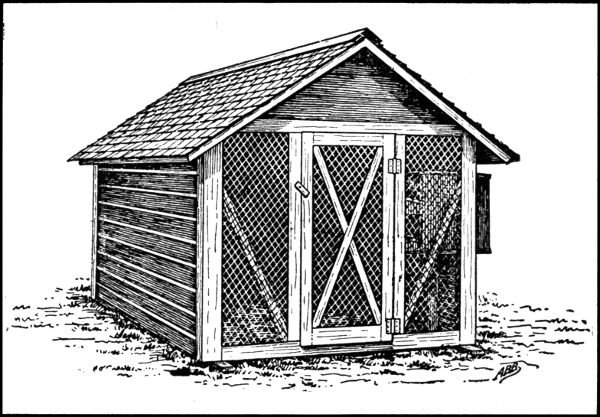
One of the Oregon Station types in which the whole end is of netting, covered with fabric in cold weather
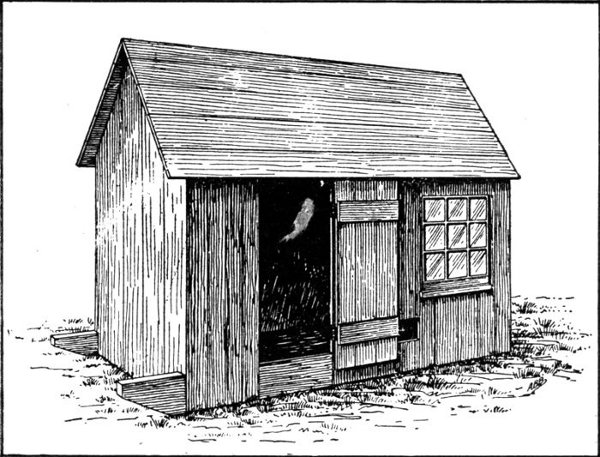
A colony house on skids, 7 × 12 feet, as recommended by the Oregon Experiment Station to accommodate 30 to 40 fowls
A building that is practically fireproof may be made of cement blocks for foundation and walls, with a concrete floor six inches higher than the outside ground. Wood may be used for the rafters and 17ceiling, the roof being covered with metal, tile, or asbestos roofing, and the inside ceiling plastered.
Another building which will provide seventy-five or one hundred fowls with roosting, scratching, and nesting-room in the winter, when foul weather makes confinement necessary, is twenty feet long, twelve feet deep, six feet high in the rear, and ten feet high in front. It has a brick foundation and a concrete floor that is ten inches above the level of the ground at the front of the building, in order to bring it well above the surface of the ground in the rear—the site is a sloping one.
In the front are three windows, one foot from the sides of the building, one foot below the top, and one foot apart. They are five feet four inches wide, three and one-half feet high, and fitted with burlap-covered18 frames, which may be lifted and fastened against the ceiling when so desired. Weather boards, sheathing paper, and narrow boards on the inside form the walls.
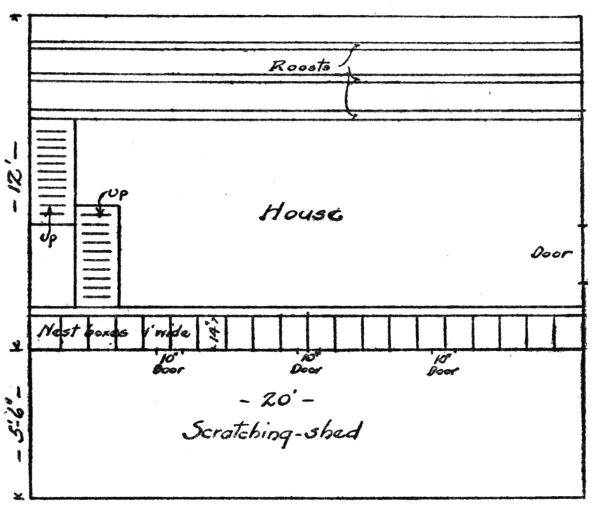
Plan of a house to give roosting, scratching and nesting accommodations to seventy-five or a hundred fowls
Directly in front, and extending the length of the building, is a glass-inclosed sun room four feet high and five feet wide.19 One end of this has a door to allow for the cleaning of the floor. The concrete floor of the main room extends into the sun room. Three openings, ten inches wide and one foot high, connect this sun room with the main room, and are provided with slides to be closed at night when the sun room is no longer a warm place.
The roosts are in the rear and extend the entire length of the building. There are three, placed four feet above the ground floor. These roosts are removable, being set in grooves cut into the wooden brackets which hold them. A hinged drop-board in sections is hung below the roosts.
The nests are forty in number in two tiers, and are fixed to the front wall of the building, below the windows. They are covered at the top, open at the side,20 and have a running-board before them one foot wide. Nests and boards are supported by stout wooden brackets about three feet apart. Nests and perches are reached by climbing-boards at one end of the room. The door is placed at the opposite end of the building, and is twenty-six inches wide and six feet high. It can be made wider if desired, as there is room.
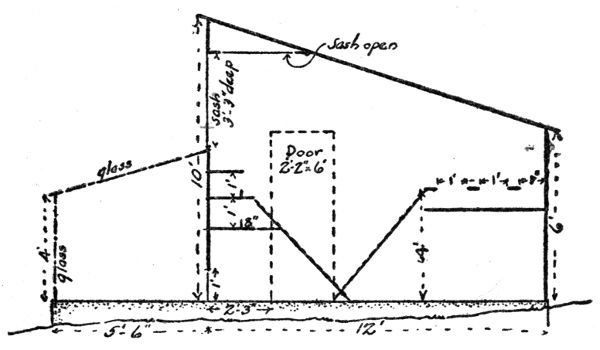
Cross-section of the house for seventy-five or a hundred fowls, showing the glazed scratching shed on the south front
The care of the young birds is greatly lightened by houses built for them especially. These need not be large nor 21elaborate, and, since they are for use in the milder seasons of the year, do not require great precautions against the cold.
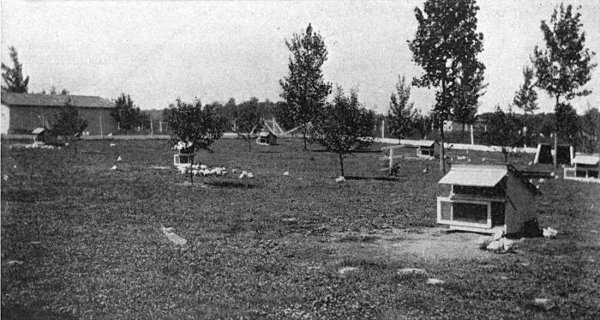
The care of the young birds is greatly lightened by the use of small houses that can be moved about
While the slant-roofed colony coops, which can be moved about, are best for the care of large flocks of growing poultry, the progeny of the small family flock may be conveniently housed in one long coop divided into compartments, with separate little pens before each division. A coop of this kind, six feet long, thirty inches wide, and twenty-seven inches high, will shelter seventy-five young chicks very comfortably from babyhood to large broiler age. The floor should be made tight and warm, and the coop mounted upon skids or runners, so that it may be moved if desired. The top of this coop slants gently and lifts up like a lid for inspection and cleaning, and this top is hinged to the rear side, and covered with tarred paper.
22Since young chicks will crowd and smother if the air supply is limited, the entire front of the coop, to seven inches above the bottom, is covered with coarse muslin or sacking during spring, and with galvanized wire netting in the summer.
The size of the lumber necessary for any of these buildings is about the same: Timber for sills, 5 × 6 in.; cross-beams and main supports, 4 × 3 in.; intermediate joists, supports, and rafters, 2 × 4 in.; and for weather boards and floor boards, any convenient width.
Well-seasoned lumber should be used, and should be first-class of its kind. Second-grade material may be used for the wood-house, but faulty building of the poultry house may mean more in losses from drafty floors or walls than the saving in the first outlay will warrant.
The floor of the poultry house sustains as important a relation to the health of the fowls as any other part of the building. A cold, drafty floor is a constant menace, inducing catarrhal affections, and a damp floor, with its constant evaporation of unwholesome moisture, is equally unfavorable.
The floor of the building bears a close relation to the foundation; indeed, its character is actually determined by the kind of foundation used. From this relation have developed three distinct styles of flooring: the earth or cement floor with brick or stone foundations; the board floor with a foundation; and the board floor without a foundation, the structure being supported on posts.
24Any one of these can be made a success if its peculiar requirements are complied with.
The board floor with a foundation makes a warm floor, but it is not durable over a perfectly tight foundation, which tends to induce rotting from the dampness of the soil beneath. To insure against this, openings should be left in either end of the foundation—openings about the size of a brick's end. In a long building, such openings should occur at intervals of ten feet.
Such places are an invitation to rats, however, and should be securely protected by heavy, close-meshed galvanized wire, or by iron grating.
The flooring must be so tight as to prevent drafts coming up through it. In the case of the board floor without a foundation, the building rests upon posts, and25 some poultrymen leave the space beneath open so that the air sweeps through beneath it. Others board up the windside. Such buildings should never be boarded all the way around, however, as rats will burrow beneath or gnaw through, giving a great deal of trouble.
Laying tin around the edges over the interlining to a width of about six inches, letting it project under the inner wall, and meeting the outer wall, will prevent rats from gnawing into the building.
A warm floor is secured by laying it double with an airtight interlining of roofing paper or similar substance. (For the lower layer of boards, hemlock answers well.) Cementing the surface of the floor gives a clean smooth surface.
An earth floor or one of cement is cold and damp, if lower or even level with the outside surface of the ground. It should26 be at least six inches higher, and, to render it dry, a layer of stone several inches deep should be placed in beneath the six inches of earth.
All floors must be cleaned frequently, fresh litter being placed in all scratching rooms, and sunlight be allowed to stream in upon them.
Where an earth floor is used, fresh earth or ashes must take the place of that cleared away each day.
Though not of secondary importance, the foundation of the poultry house is a secondary consideration, for after one has decided upon his location, manner of building, and the best kind of floor for his hens under those conditions, he may come to a conclusion about the foundation.
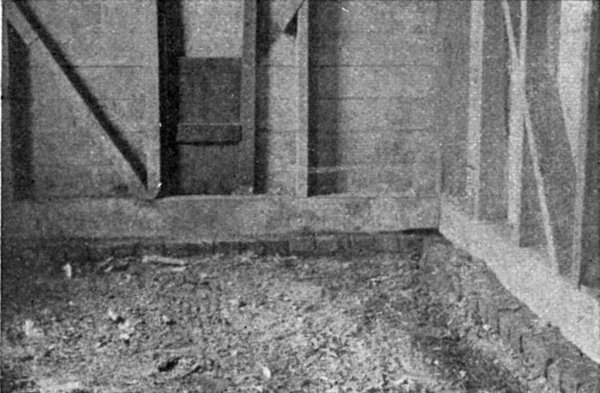
An earth floor lower than the outside surface is cold and damp
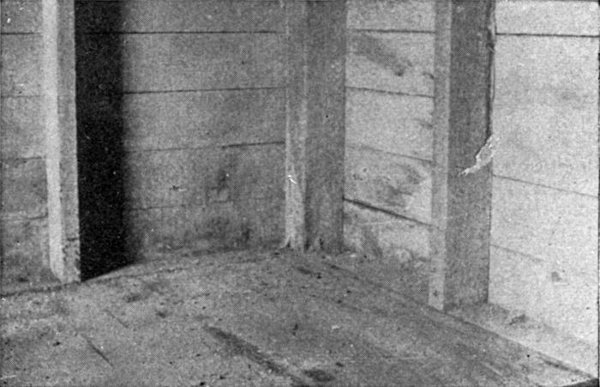
The flooring must be perfectly tight to prevent drafts coming through it
The brick, concrete, or stone continuous foundations have such a stable appearance that, looks alone considered, they are preferable to posts. Where brick or concrete 27posts are used, however, the effect is not unstable.
On a good building site, I like the brick or concrete foundation, and would have no other. Under such conditions, it meets the requirements of a durable building for fowls.
The foundation of the poultry house need not be deeper than two or two and one-half feet below the surface of the ground, according to the climate of the locality. The object is to lay it below the freezing point. It must be high enough to actually raise the building above the earth and its dampness. Where the soil washes in around the foundation, gradually covering it and partly burying the wood above, it is likely to cause the weather boards to decay around the base.
Get a man who understands his job to do the work of foundation-laying, else your superstructure will suffer.
The roof of the poultry house is, for the average poultryman, a problem solved by the state of his pocketbook, climate, and the location of his buildings, as well as personal preference.
The shape of the roof may be governed by taste, the prevailing type of architecture, etc., but where the welfare of the fowls themselves is jeopardized by a certain style, personal preference must yield and the health of the birds themselves determine the choice.
Roofs that can be made watertight with the least difficulty, which do not overhang so far as to prevent sunlight from entering the windows, and which are sightly, are the aim of the average builder.
29Considered from the point of utility alone, the single-pitched roof seems to be the most popular. It gives the necessary watershed and interior room for the least amount of material.
While the height of the roof from the floor should be influenced by the other dimensions of the building, the fowls will do as well with a low-roofed building properly cleaned and ventilated, as with one of lofty roof, but the inconvenience of caring for the low-roofed building must be considered, and hence few of us want a roof lower than six feet.
After one has decided the form of the roof, the next point is the material.
In counting the cost, one must consider the possible expense in keeping in repair a roof cheap at the outset. Some roofs absorb the sun's rays to such a degree as to make the building too warm. In certain30 locations a fireproof roof is imperative, by law or expediency.
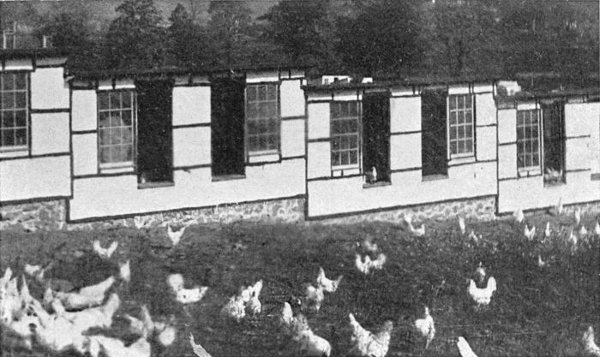
The single-pitched roof is the most economical of material and labor, a consideration of importance in the housing of large flocks
Wood, metal, and the tarred paper or felt roofing have peculiar qualifications which adapt them to individual requirements. The paper or felt roofings appeal to a great many people, as the work of applying the material can be done by an amateur. These roofings are laid on over boards and secured in position by nails, the joinings being made watertight with cement. Pliant roofings should be turned well over the edges of the roof and fastened securely. Allowance for lapping of the strips is made on the material, and this lap should be observed. The cost of the cement and nails necessary to the work is included in the price of the roofing per roll. There are several good tarred roofings on the market at one dollar and eighty cents or one dollar and ninety cents 31per roll of about one hundred square feet. When buying, it is best to select those having a fireproof surface. Two-ply felt roofing is more economical than the one-ply, as it makes a much more lasting roof. After three or four years it will require repainting, and this must be done promptly to preserve the roof. The price of the felt roofings varies, costing from two to two and one-half dollars per square.
All flexible roofings must be laid over boards that are fitted closely, else they will tend to break over the crevices.
The galvanized steel and iron roofings are the most durable of all. The best grade of galvanized iron costs from four dollars and twenty-five cents to five dollars per square (100 square feet), covering the cost of laying, but as it is absolutely fireproof, lower insurance rates are obtainable on buildings where it is used.
32The galvanized roof is very warm in summer, which in some sections proves an objection. Tarred paper also is hot.
Roofs of cedar or white pine shingles outlast the pliant roofings, and really cost less in the end. One poultryman who has had experience with metal, felt, paper, and shingle roofing, prefers the last, claiming that it serves him best for least cost.
Where other buildings have just been constructed, there may be left-over roofing material of a higher grade, which will serve to cover the poultry house. Roofing tile and asbestos shingles make excellent roofs, and are very sightly, but their use demands a different treatment of the roof framing, and an experienced workman to make a satisfactory job.
Obtain an influx of fresh air without drafts and without too great cooling of the air, and you have solved the problem of ventilation. To prevent an undue fall of temperature, there must be, in addition to a fresh-air supply, a continuous heat supply, and this exists in the fowls themselves. This we must plan to conserve. Admitting the fabric-covered window—now so universally used—to be the best solution of how to admit fresh air with the least loss of heat, the accompaniment of this is perfect tightness of the windowless sides.
As far as materials are concerned, wood, brick, cement blocks, or stone, are equally34 satisfactory if their requirements are understood, and they are used to suit conditions. Some poultrymen object to brick or stone, claiming that they are damp, yet we know that stone does not create moisture. Of course, masonry being a better conductor of heat than wood, moisture already in the air will condense upon stone, concrete, etc., when it will not be evident on wood. The moisture-laden air, which is cold and unhealthy for the fowls, must be due to a damp floor, poor ventilation, or some such reason. The fact that a certain concrete or stone wall is dry would prove that conditions were right, while the wooden wall would show warning signs only in extreme dampness.
In localities where stone abounds, the entire building may be constructed of stone, giving ample window room.
All buildings which are plastered or cemented35 in any part of their construction should be allowed to dry thoroughly before the flock moves in.
As an important aid to uniformity of temperature in winter, the wall space filled with confined air is important. The cement blocks and hollow building tile provide for this to a certain extent. A double board wall may give this result if carefully constructed. By placing sheathing paper under the weather boards, and also under the ceiling boards, a very satisfactory wall is possible.
A warm wall is made by combining brick and boards—using weather boards outside, brick within, and plaster, or ceiling boards, on the inner side.
A single board wall can be made comfortable as winter quarters by covering the outside with roofing paper and having it painted black. These black-painted36 hen houses and coops are too warm in summer, however.
The inside walls of the hen house should be smooth enough to be kept clean. A good wood-filler in the crevices prevents lice and mites from lodging there, but if, when whitewashing the walls, care is taken to work the lime into the crevices with the brush, and this work is done often enough, say four times a year, such pests would be kept down.
Make it a rule to have the windows on the light, sunny side of the building, facing south or southeast, but have none on the other three sides.
Windows really ought to be of such a size and position that the sunlight can reach every part of the floor space during some part of the day. Though we all believe in the benefit of sunlight, we do not always realize how important a part it37 plays in the care of poultry. When we consider that vermin and disease thrive in its absence, and that remedial measures are more or less troublesome and expensive, we will work into our building schemes every possible inlet for sunlight.
The windows should occupy a large part of the front wall area—one-third of it, at least, and be evenly distributed over the upper part of the surface. Movable window sash or curtain frames are imperative.
The position of the ventilating arrangement depends upon the position of the fowls at night. It is a strange fact that human beings, animals, and poultry can better stand a current of air coming directly toward the front of the head than from the rear or sides; hence I would place the roosts so that the fowls face the window and get the fresh air on a level with the nostrils rather than from above or38 below. Thus they are fortified against a drop in temperature. For example, where the roosts are to be two feet above the floor, I would have the windows about twenty inches from the floor, provided the roof is correspondingly low. With the roosts three or four feet above the floor, the window should be from thirty-two to forty-four inches above the floor, etc. I think it is safe to have the windows not higher than eight or twelve inches below the eaves, and six inches from the sides of the building.
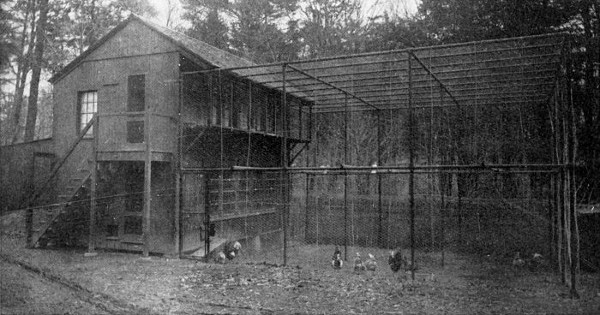
When pigeons as well as chickens are kept the shelters for both may be economically combined
Despite the fact that some poultrymen have discarded glass, I cannot rule it out altogether. It certainly has its uses on cold wintry days when the heat of the sun's rays is wanted without the chill wintry air. I believe these glass windows should be covered at night, and that the fabric curtain is therefore the most sensible 39mode of night ventilation. Burlap, sacking, or coarse muslin may be used to cover the window frames. Burlap is the most substantial. In tacking it to the frame, tacks with tin discs beneath the head (like those with roofing nails) may be used, or a thin light strip of wood may bind the burlap to the frame, and through it the tacks are driven.
Wherever glass is used, some protection of poultry wire is necessary to prevent its being broken.
It aids in ridding the house of dust if, when the fowls are out, a searching breeze can blow through occasionally. For this reason, end doors are a great advantage, but they must be draft-proof.
The good points of an otherwise well-built poultry house may be set at naught by carelessly made doors, which fit loosely in their casings.
Doors which open on the cold or exposed side of a building require more precautions against drafts than those on the sunny side. The door should be of tightly fitted boards, and covered on the inner side with tarred roofing paper, or thin, narrow boards.
41The following hints are for a door that is practically draft-proof: For the door itself use tongue-and-groove boards, an inch thick, reinforced six inches from the top and bottom by cross-pieces six inches wide, and beneath the latch by a rectangle of the same wood. Over this is tacked sheathing paper, fitting it about the cross-pieces. The inner side is finished with narrow tongue-and-groove ceiling boards. (These may be placed over the battens or between them.) In case they are to be placed over the battens, the open space between the two board surfaces is closed with a narrow wooden strip.
The door casing is five inches thick, the sill board six inches wide, and slanting to one inch lower on the outside than on the inside. On the sides and across the upper part of the door casing are nailed inch-thick strips which, with the edge of the42 casing against which the door shuts, gives a two-inch edge which effectually excludes air currents. Against the lower edge of the door is a heavy strip of felt, reinforced with leather where it is tacked to the door.
When we have come to the interior fittings of the poultry house, we are about ready for the flock to move in, and may consult the peculiarities of our chosen breed to some extent.
In the matter of nests, heavier breeds of fowls need them of easier access than do the lighter breeds. The latter class seem to enjoy an ascent to their nests, and it is as well to favor them.
The nests may be around the sides of the building, beneath the roosts and drop-board, or in any convenient place, and there should be as many as there is room for. Nests that are scattered about and possess some distinctive characteristics seem to make a greater appeal to some44 fowls. Nests in tiers of three or in blocks of three seem to be readily identified by the hens if the different sets of nests are differently placed, but a row of half a dozen nests exactly alike is confusing to the average hen.
When space is at a premium, the nests should stand beneath the roosts, protected by a wooden drop-board—smooth to be vermin-proof and removable to be sanitary. A hinged board serves to darken the nest and at the same time can be held up by a hook when so desired. For cleanliness the nest should be made of wood and treated with some vermin preventive which should be washed well into all crevices. If the nest is raised four or five inches from the floor and built with a porous bottom, it is more easily kept dry. The compartments should be separated to prevent interference between layers. Each45 of these should be, as a rule, 16 × 12 × 14 inches, although I am now using nests 13½ in. long by 10½ in. wide and 12 in. high. In order to be lifted for cleaning some light material must be used. A convenient arrangement is a long, narrow box, fitting the available space, divided by partitions into individual nests. Wire netting makes a very good bottom for this type of nest. I like either this or the slat bottom, through which the dust and worn nest material sift and the air circulates. Of course, such a nest should be supported on brackets or suspended so that the air can penetrate its parts. Grocer's boxes may be converted into good nests by removing the bottom and tacking smooth slats across, with one and one-half inches of space between each. Inch-meshed poultry wire may be used if one is going to use the wire netting. A coat of paint46 gives a more sanitary surface, but if this is not practicable, the wood should be planed as smooth as possible and whitewashed.
Concealment is usually favorable to the use of the nests, and if the apartment is light and sunny, a board screen may be used to secure this, or the nest entrance may be turned away from the light. I am using curtains of sacking with marked increase of popularity among my fowls. Nests which were persistently shunned are now constantly used since thus darkened. The sacking may be hung from a wooden strip placed in front of the nests. It gets dusty, but if one is provided with two or three such curtains, the soiled ones may be hung outdoors in the wind and rain for cleansing.
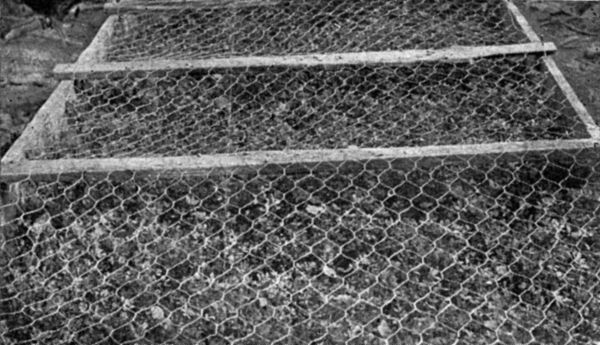
Alfalfa in the run under netting, through which the hens may pick
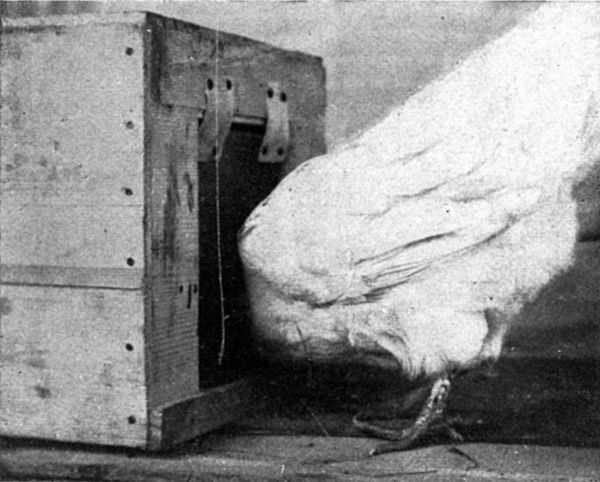
Even with the small flock the trap nest should be used—there is no use feeding non-producers
The trap nest is as useful to the small poultryman as to the man who runs a 47large poultry plant. It is so arranged that each laying hen and her product may be identified. A trap nest may be improvised from a box of suitable size. Cut out entrance and exit in opposite sides, and in each suspend a door so that it will swing at a pressure of the fowl's head. The entrance door swings inward only—the exit door swings outward. After the egg is laid, the hen passes through the exit into a small inclosure, from which she is liberated after her achievement has been recorded.
Where rational methods are used in nest construction, it is hardly necessary to use nest-eggs to secure the fowl's patronage of the nests. Where they are used, however, those of dull finish are preferable to the smooth glass ones.
Hens want a roost that they can clasp with their toes. It should be broad48 enough to support the bird's weight upon the ball of the foot and thin enough to allow the toes to curl under. This act is a reflex one and as much a part of their slumber as scratching is a part of their waking activities. This power of clasping the perch seems to belong to birds in vigorous conditions. Ailing birds that cannot roost seldom have enough vitality to recover.
Roosts two and one-quarter inches wide and not more than an inch thick, with slightly rounded edges favoring the curl of the toes, are satisfactory. They may be arranged horizontally, or slightly inclined, ladder fashion. Light poles cut from young saplings make suitable roosts, if scraped clean of bark and shaved to flatten them slightly on the upper side. Horizontal roosts may be placed about one foot apart, and not more than three49 lying parallel, or the fowls roosting on the rear perch do not get enough air. I prefer them slightly inclined, ladder fashion, at an angle of nearly thirty degrees, the lowest perch not lower than three feet from the floor, and not more than three perches parallel. Where the fabric curtain is used, all get the benefit of the fresh air coming through the canvas curtain.
The runs are essentially a part of the problem of housing. Fowls need plenty of exercise, yet they are entirely too meddlesome to be given full liberty where one has a garden, a good lawn, and flowers. While hens may be kept in buildings and, with proper care, still retain their health, the average owner of a small flock can keep the birds more economically if he gives them the natural advantages of outdoor exercise.
The most useful run is the divided pen, each section to be used alternately.
For the active-laying breeds, three runs, about ten by forty feet, to be used alternately by the flock of forty hens, are advisable. Where two are used the dimensions51 should be greater—say ten by sixty.
A yard inclosure for large birds requires two-inch meshed poultry wire, five and one-half or six feet in width, supported by posts set nine or ten feet apart. The wire is attached to the posts by staples about four inches apart. A wooden strip or any other finish along the top of the fence is an objection. The lower edge of the wire requires a board or strip to which it is tacked. Boards six inches wide may be used for this.
The poultry house, no matter how carefully built, is not a fit place for poultry, if it is neglected. Cobwebs draped across the corners hold dust and disease germs. Neglected perches become mite-infested and are thereafter a menace to the health of the poultry. Grooves and crevices in walls harbor mites, lice, and disease. Burlap curtains that become dusty do not readily admit pure air, or else convey a cloud of dust directly back to the fowls. Floors that are covered with an accumulation of dirt become damp and cold, aside from the danger of contamination.
Window panes that are cloudy with dirt do not admit sunlight properly.
53The proper care of the poultry house means work, and the place seems hopelessly unlovely when the task has been ignored from day to day, and one's sins of omission are seen in the aggregate. The proper way to perform such work is daily, when but a few minutes will serve to keep the building sanitary.
The litter of straw should be changed frequently, say, every third day—the floor swept and fresh litter spread upon it.
The droppings should be removed daily. A little fine dry sand acts as an absorbent if sprinkled over the cleaned surface.
Walls should be swept down once a week, giving attention to corners, under and behind nests, perches, etc. For this purpose a splint broom, such as is used around stables, is most useful.
For thorough cleansing after all loose dirt has been swept away nothing is superior54 to whitewashing. It makes the room lighter, sweetens the air, and is a "cold shoulder" to all vermin. A sprinkling of dilute carbolic acid is a safeguard against disease. Perches are best cleaned by washing with some liquid insecticide, and then allowing them to dry in the sun. A good wash is made by dissolving half a cake of any laundry soap in ten quarts of water and adding five tablespoonfuls of kerosene oil.
Transcriber's note:
Ambiguous hyphens at the ends of lines were retained and illustrations moved to paragraph breaks.
The following corrections have been made:
p. 11 are 14 in. long., -> removed period after long
p. 11 to 5-in. height -> removed hyphen after 5
Everything else has been retained as printed.
End of Project Gutenberg's Making a Poultry House, by Mary Roberts Conover
*** END OF THIS PROJECT GUTENBERG EBOOK MAKING A POULTRY HOUSE ***
***** This file should be named 44472-h.htm or 44472-h.zip *****
This and all associated files of various formats will be found in:
http://www.gutenberg.org/4/4/4/7/44472/
Produced by Sandra Eder and the Online Distributed
Proofreading Team at http://www.pgdp.net (This file was
produced from images generously made available by The
Internet Archive)
Updated editions will replace the previous one--the old editions
will be renamed.
Creating the works from public domain print editions means that no
one owns a United States copyright in these works, so the Foundation
(and you!) can copy and distribute it in the United States without
permission and without paying copyright royalties. Special rules,
set forth in the General Terms of Use part of this license, apply to
copying and distributing Project Gutenberg-tm electronic works to
protect the PROJECT GUTENBERG-tm concept and trademark. Project
Gutenberg is a registered trademark, and may not be used if you
charge for the eBooks, unless you receive specific permission. If you
do not charge anything for copies of this eBook, complying with the
rules is very easy. You may use this eBook for nearly any purpose
such as creation of derivative works, reports, performances and
research. They may be modified and printed and given away--you may do
practically ANYTHING with public domain eBooks. Redistribution is
subject to the trademark license, especially commercial
redistribution.
*** START: FULL LICENSE ***
THE FULL PROJECT GUTENBERG LICENSE
PLEASE READ THIS BEFORE YOU DISTRIBUTE OR USE THIS WORK
To protect the Project Gutenberg-tm mission of promoting the free
distribution of electronic works, by using or distributing this work
(or any other work associated in any way with the phrase "Project
Gutenberg"), you agree to comply with all the terms of the Full Project
Gutenberg-tm License available with this file or online at
www.gutenberg.org/license.
Section 1. General Terms of Use and Redistributing Project Gutenberg-tm
electronic works
1.A. By reading or using any part of this Project Gutenberg-tm
electronic work, you indicate that you have read, understand, agree to
and accept all the terms of this license and intellectual property
(trademark/copyright) agreement. If you do not agree to abide by all
the terms of this agreement, you must cease using and return or destroy
all copies of Project Gutenberg-tm electronic works in your possession.
If you paid a fee for obtaining a copy of or access to a Project
Gutenberg-tm electronic work and you do not agree to be bound by the
terms of this agreement, you may obtain a refund from the person or
entity to whom you paid the fee as set forth in paragraph 1.E.8.
1.B. "Project Gutenberg" is a registered trademark. It may only be
used on or associated in any way with an electronic work by people who
agree to be bound by the terms of this agreement. There are a few
things that you can do with most Project Gutenberg-tm electronic works
even without complying with the full terms of this agreement. See
paragraph 1.C below. There are a lot of things you can do with Project
Gutenberg-tm electronic works if you follow the terms of this agreement
and help preserve free future access to Project Gutenberg-tm electronic
works. See paragraph 1.E below.
1.C. The Project Gutenberg Literary Archive Foundation ("the Foundation"
or PGLAF), owns a compilation copyright in the collection of Project
Gutenberg-tm electronic works. Nearly all the individual works in the
collection are in the public domain in the United States. If an
individual work is in the public domain in the United States and you are
located in the United States, we do not claim a right to prevent you from
copying, distributing, performing, displaying or creating derivative
works based on the work as long as all references to Project Gutenberg
are removed. Of course, we hope that you will support the Project
Gutenberg-tm mission of promoting free access to electronic works by
freely sharing Project Gutenberg-tm works in compliance with the terms of
this agreement for keeping the Project Gutenberg-tm name associated with
the work. You can easily comply with the terms of this agreement by
keeping this work in the same format with its attached full Project
Gutenberg-tm License when you share it without charge with others.
1.D. The copyright laws of the place where you are located also govern
what you can do with this work. Copyright laws in most countries are in
a constant state of change. If you are outside the United States, check
the laws of your country in addition to the terms of this agreement
before downloading, copying, displaying, performing, distributing or
creating derivative works based on this work or any other Project
Gutenberg-tm work. The Foundation makes no representations concerning
the copyright status of any work in any country outside the United
States.
1.E. Unless you have removed all references to Project Gutenberg:
1.E.1. The following sentence, with active links to, or other immediate
access to, the full Project Gutenberg-tm License must appear prominently
whenever any copy of a Project Gutenberg-tm work (any work on which the
phrase "Project Gutenberg" appears, or with which the phrase "Project
Gutenberg" is associated) is accessed, displayed, performed, viewed,
copied or distributed:
This eBook is for the use of anyone anywhere at no cost and with
almost no restrictions whatsoever. You may copy it, give it away or
re-use it under the terms of the Project Gutenberg License included
with this eBook or online at www.gutenberg.org
1.E.2. If an individual Project Gutenberg-tm electronic work is derived
from the public domain (does not contain a notice indicating that it is
posted with permission of the copyright holder), the work can be copied
and distributed to anyone in the United States without paying any fees
or charges. If you are redistributing or providing access to a work
with the phrase "Project Gutenberg" associated with or appearing on the
work, you must comply either with the requirements of paragraphs 1.E.1
through 1.E.7 or obtain permission for the use of the work and the
Project Gutenberg-tm trademark as set forth in paragraphs 1.E.8 or
1.E.9.
1.E.3. If an individual Project Gutenberg-tm electronic work is posted
with the permission of the copyright holder, your use and distribution
must comply with both paragraphs 1.E.1 through 1.E.7 and any additional
terms imposed by the copyright holder. Additional terms will be linked
to the Project Gutenberg-tm License for all works posted with the
permission of the copyright holder found at the beginning of this work.
1.E.4. Do not unlink or detach or remove the full Project Gutenberg-tm
License terms from this work, or any files containing a part of this
work or any other work associated with Project Gutenberg-tm.
1.E.5. Do not copy, display, perform, distribute or redistribute this
electronic work, or any part of this electronic work, without
prominently displaying the sentence set forth in paragraph 1.E.1 with
active links or immediate access to the full terms of the Project
Gutenberg-tm License.
1.E.6. You may convert to and distribute this work in any binary,
compressed, marked up, nonproprietary or proprietary form, including any
word processing or hypertext form. However, if you provide access to or
distribute copies of a Project Gutenberg-tm work in a format other than
"Plain Vanilla ASCII" or other format used in the official version
posted on the official Project Gutenberg-tm web site (www.gutenberg.org),
you must, at no additional cost, fee or expense to the user, provide a
copy, a means of exporting a copy, or a means of obtaining a copy upon
request, of the work in its original "Plain Vanilla ASCII" or other
form. Any alternate format must include the full Project Gutenberg-tm
License as specified in paragraph 1.E.1.
1.E.7. Do not charge a fee for access to, viewing, displaying,
performing, copying or distributing any Project Gutenberg-tm works
unless you comply with paragraph 1.E.8 or 1.E.9.
1.E.8. You may charge a reasonable fee for copies of or providing
access to or distributing Project Gutenberg-tm electronic works provided
that
- You pay a royalty fee of 20% of the gross profits you derive from
the use of Project Gutenberg-tm works calculated using the method
you already use to calculate your applicable taxes. The fee is
owed to the owner of the Project Gutenberg-tm trademark, but he
has agreed to donate royalties under this paragraph to the
Project Gutenberg Literary Archive Foundation. Royalty payments
must be paid within 60 days following each date on which you
prepare (or are legally required to prepare) your periodic tax
returns. Royalty payments should be clearly marked as such and
sent to the Project Gutenberg Literary Archive Foundation at the
address specified in Section 4, "Information about donations to
the Project Gutenberg Literary Archive Foundation."
- You provide a full refund of any money paid by a user who notifies
you in writing (or by e-mail) within 30 days of receipt that s/he
does not agree to the terms of the full Project Gutenberg-tm
License. You must require such a user to return or
destroy all copies of the works possessed in a physical medium
and discontinue all use of and all access to other copies of
Project Gutenberg-tm works.
- You provide, in accordance with paragraph 1.F.3, a full refund of any
money paid for a work or a replacement copy, if a defect in the
electronic work is discovered and reported to you within 90 days
of receipt of the work.
- You comply with all other terms of this agreement for free
distribution of Project Gutenberg-tm works.
1.E.9. If you wish to charge a fee or distribute a Project Gutenberg-tm
electronic work or group of works on different terms than are set
forth in this agreement, you must obtain permission in writing from
both the Project Gutenberg Literary Archive Foundation and Michael
Hart, the owner of the Project Gutenberg-tm trademark. Contact the
Foundation as set forth in Section 3 below.
1.F.
1.F.1. Project Gutenberg volunteers and employees expend considerable
effort to identify, do copyright research on, transcribe and proofread
public domain works in creating the Project Gutenberg-tm
collection. Despite these efforts, Project Gutenberg-tm electronic
works, and the medium on which they may be stored, may contain
"Defects," such as, but not limited to, incomplete, inaccurate or
corrupt data, transcription errors, a copyright or other intellectual
property infringement, a defective or damaged disk or other medium, a
computer virus, or computer codes that damage or cannot be read by
your equipment.
1.F.2. LIMITED WARRANTY, DISCLAIMER OF DAMAGES - Except for the "Right
of Replacement or Refund" described in paragraph 1.F.3, the Project
Gutenberg Literary Archive Foundation, the owner of the Project
Gutenberg-tm trademark, and any other party distributing a Project
Gutenberg-tm electronic work under this agreement, disclaim all
liability to you for damages, costs and expenses, including legal
fees. YOU AGREE THAT YOU HAVE NO REMEDIES FOR NEGLIGENCE, STRICT
LIABILITY, BREACH OF WARRANTY OR BREACH OF CONTRACT EXCEPT THOSE
PROVIDED IN PARAGRAPH 1.F.3. YOU AGREE THAT THE FOUNDATION, THE
TRADEMARK OWNER, AND ANY DISTRIBUTOR UNDER THIS AGREEMENT WILL NOT BE
LIABLE TO YOU FOR ACTUAL, DIRECT, INDIRECT, CONSEQUENTIAL, PUNITIVE OR
INCIDENTAL DAMAGES EVEN IF YOU GIVE NOTICE OF THE POSSIBILITY OF SUCH
DAMAGE.
1.F.3. LIMITED RIGHT OF REPLACEMENT OR REFUND - If you discover a
defect in this electronic work within 90 days of receiving it, you can
receive a refund of the money (if any) you paid for it by sending a
written explanation to the person you received the work from. If you
received the work on a physical medium, you must return the medium with
your written explanation. The person or entity that provided you with
the defective work may elect to provide a replacement copy in lieu of a
refund. If you received the work electronically, the person or entity
providing it to you may choose to give you a second opportunity to
receive the work electronically in lieu of a refund. If the second copy
is also defective, you may demand a refund in writing without further
opportunities to fix the problem.
1.F.4. Except for the limited right of replacement or refund set forth
in paragraph 1.F.3, this work is provided to you 'AS-IS', WITH NO OTHER
WARRANTIES OF ANY KIND, EXPRESS OR IMPLIED, INCLUDING BUT NOT LIMITED TO
WARRANTIES OF MERCHANTABILITY OR FITNESS FOR ANY PURPOSE.
1.F.5. Some states do not allow disclaimers of certain implied
warranties or the exclusion or limitation of certain types of damages.
If any disclaimer or limitation set forth in this agreement violates the
law of the state applicable to this agreement, the agreement shall be
interpreted to make the maximum disclaimer or limitation permitted by
the applicable state law. The invalidity or unenforceability of any
provision of this agreement shall not void the remaining provisions.
1.F.6. INDEMNITY - You agree to indemnify and hold the Foundation, the
trademark owner, any agent or employee of the Foundation, anyone
providing copies of Project Gutenberg-tm electronic works in accordance
with this agreement, and any volunteers associated with the production,
promotion and distribution of Project Gutenberg-tm electronic works,
harmless from all liability, costs and expenses, including legal fees,
that arise directly or indirectly from any of the following which you do
or cause to occur: (a) distribution of this or any Project Gutenberg-tm
work, (b) alteration, modification, or additions or deletions to any
Project Gutenberg-tm work, and (c) any Defect you cause.
Section 2. Information about the Mission of Project Gutenberg-tm
Project Gutenberg-tm is synonymous with the free distribution of
electronic works in formats readable by the widest variety of computers
including obsolete, old, middle-aged and new computers. It exists
because of the efforts of hundreds of volunteers and donations from
people in all walks of life.
Volunteers and financial support to provide volunteers with the
assistance they need are critical to reaching Project Gutenberg-tm's
goals and ensuring that the Project Gutenberg-tm collection will
remain freely available for generations to come. In 2001, the Project
Gutenberg Literary Archive Foundation was created to provide a secure
and permanent future for Project Gutenberg-tm and future generations.
To learn more about the Project Gutenberg Literary Archive Foundation
and how your efforts and donations can help, see Sections 3 and 4
and the Foundation information page at www.gutenberg.org
Section 3. Information about the Project Gutenberg Literary Archive
Foundation
The Project Gutenberg Literary Archive Foundation is a non profit
501(c)(3) educational corporation organized under the laws of the
state of Mississippi and granted tax exempt status by the Internal
Revenue Service. The Foundation's EIN or federal tax identification
number is 64-6221541. Contributions to the Project Gutenberg
Literary Archive Foundation are tax deductible to the full extent
permitted by U.S. federal laws and your state's laws.
The Foundation's principal office is located at 4557 Melan Dr. S.
Fairbanks, AK, 99712., but its volunteers and employees are scattered
throughout numerous locations. Its business office is located at 809
North 1500 West, Salt Lake City, UT 84116, (801) 596-1887. Email
contact links and up to date contact information can be found at the
Foundation's web site and official page at www.gutenberg.org/contact
For additional contact information:
Dr. Gregory B. Newby
Chief Executive and Director
gbnewby@pglaf.org
Section 4. Information about Donations to the Project Gutenberg
Literary Archive Foundation
Project Gutenberg-tm depends upon and cannot survive without wide
spread public support and donations to carry out its mission of
increasing the number of public domain and licensed works that can be
freely distributed in machine readable form accessible by the widest
array of equipment including outdated equipment. Many small donations
($1 to $5,000) are particularly important to maintaining tax exempt
status with the IRS.
The Foundation is committed to complying with the laws regulating
charities and charitable donations in all 50 states of the United
States. Compliance requirements are not uniform and it takes a
considerable effort, much paperwork and many fees to meet and keep up
with these requirements. We do not solicit donations in locations
where we have not received written confirmation of compliance. To
SEND DONATIONS or determine the status of compliance for any
particular state visit www.gutenberg.org/donate
While we cannot and do not solicit contributions from states where we
have not met the solicitation requirements, we know of no prohibition
against accepting unsolicited donations from donors in such states who
approach us with offers to donate.
International donations are gratefully accepted, but we cannot make
any statements concerning tax treatment of donations received from
outside the United States. U.S. laws alone swamp our small staff.
Please check the Project Gutenberg Web pages for current donation
methods and addresses. Donations are accepted in a number of other
ways including checks, online payments and credit card donations.
To donate, please visit: www.gutenberg.org/donate
Section 5. General Information About Project Gutenberg-tm electronic
works.
Professor Michael S. Hart was the originator of the Project Gutenberg-tm
concept of a library of electronic works that could be freely shared
with anyone. For forty years, he produced and distributed Project
Gutenberg-tm eBooks with only a loose network of volunteer support.
Project Gutenberg-tm eBooks are often created from several printed
editions, all of which are confirmed as Public Domain in the U.S.
unless a copyright notice is included. Thus, we do not necessarily
keep eBooks in compliance with any particular paper edition.
Most people start at our Web site which has the main PG search facility:
www.gutenberg.org
This Web site includes information about Project Gutenberg-tm,
including how to make donations to the Project Gutenberg Literary
Archive Foundation, how to help produce our new eBooks, and how to
subscribe to our email newsletter to hear about new eBooks.